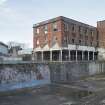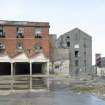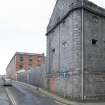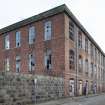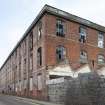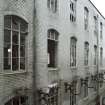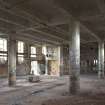Aberdeen, Maberly Street, Broadford Works, Weaving And Wefting Mill
Mill (Period Unassigned), Warehouse (Period Unassigned)
Site Name Aberdeen, Maberly Street, Broadford Works, Weaving And Wefting Mill
Classification Mill (Period Unassigned), Warehouse (Period Unassigned)
Alternative Name(s) Broadford Firehose And Canvas Works; Maberley Street
Canmore ID 291124
Site Number NJ90NW 125.11
NGR NJ 93519 06879
NGR Description Centred NJ 93519 06879
Datum OSGB36 - NGR
Permalink http://canmore.org.uk/site/291124
- Council Aberdeen, City Of
- Parish Aberdeen
- Former Region Grampian
- Former District City Of Aberdeen
- Former County Aberdeenshire
NJ90NW 125.11 centred 93519 06879
Weaving and weft winding mill built 1912, designed by Wilson and Walker. Built in reinforced concrete, brick-clad with flat roof. The cropping and cloth inspection section at N end.
The sewing mill was built in 1904 and designed by R G Wilson. Arched floors on iron columns with steel roof trusses. The buildig stands on the site of a three-storey hand loom factory dated, c.1811-14.
The N weaving shed is single storey built in mid-nineteenth century. Internally also housed a twin beam engine house, which was rebuilt in 1908 for an engine still working as late as 1935.
S weaving shed built c.1870, extended over the basement flax, tow and yarn stores also the hemp breaking and softening departments which were designed by Wilson and Walker in 1909. The whole building was rebuilt in 1980.
Calender House built c.1870 is a 'lofty' single storey with a mezzanine floor and use for cloth finishing.
M. Watson (1992)
Standing Building Recording (2 October 2015 - 11 January 2017)
A standing building survey was carried out at the former Broadford Works primarily of buildings to be demolished prior to the conversion of the site to an urban village. Broadford Works was originally constructed by Fenton Murray and Wood of Leeds in 1808 for Scott Brown and Co of Angus, it went bankrupt in 1811 and sold to Sir John Maberly MP, entrepreneur, speculator and introducer of jute to the UK. Maberley rapidly developed Broadford Works, adopting the first gas lighting of an industrial complex in Scotland, by Boulton and Watt in 1814-15, and Scotland's second power loom linen weaving factory in Scotland in 1824. Maberly was himself bankrupt and in 1834 the works passed to Richards and Co, who had a bleachworks at Rubislaw and branches at Montrose and produced canvas tarpaulins and as a particular specialism, fire hoses. In the 1830s the business was taken over by John Baker Richards, a London merchant. Under his ownership and name the company expanded through the 19th century. By the 1880s eight steam engines drove the plant and some 3,000 millhands were employed, once the largest employer in Aberdeen. The company manufactured linen sheeting, towelling sail canvas, tent cloth and hose web.
Information from Oasis (camerona1-275259) 17 February 2017
Standing Building Recording (2 October 2015 - 11 January 2017)
NJ 93609 06881 (NJ90NW 125) A standing building survey was carried out, 2 October 2015 – 11 January 2017, primarily of buildings to be demolished prior to the creation of an urban village. The current condition of the buildings being retained was also recorded.
Broadford Works was originally constructed by Fenton Murray and Wood of Leeds in 1808 for Scott Brown and Co. of Angus. It went bankrupt in 1811 and was sold to Sir John Maberly MP, entrepreneur, speculator and introducer of jute to the UK. Maberly rapidly developed Broadford Works,
adopting the first gas lighting of an industrial complex in Scotland, by Boulton and Watt in 1814–15, and Scotland’s second power loom linen weaving factory in Scotland in 1824. Maberly was himself bankrupt and in 1834 the works passed to Richards and Co., who had a bleachworks at
Rubislaw and branches at Montrose, and produced canvas tarpaulins, and as a particular specialism, fire hoses. In the 1830s the business was taken over by John Baker Richards, a London merchant. Under his ownership and name the company expanded through the 19th century. By the 1880s
eight steam engines drove the plant and some 3000 mill hands were employed. The company manufactured linen sheeting, towelling, sail canvas, tent cloth and hose web. Most of the buildings to be demolished were later additions and all the older mill buildings are being retained.
Archive: NRHE
Funder: First Construction Ltd
Alison Cameron - Cameron Archaeology
(Source: DES, Volume 18)




































































































